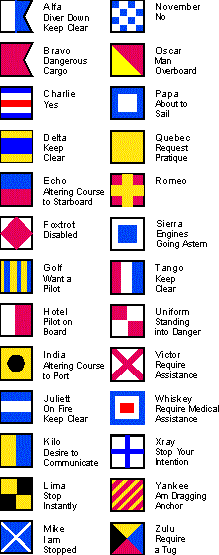Flag Dictionary
TERMINOLOGY
Badge – a coat of arms or simple heraldic symbol, such as a shield.
Bunting - is cloth decorated with the national colors. The term is also used for the woolen cloth used in making flags.
Canton – any quarter of a flag, but commonly means the upper left (hoist) quarter, such as the field of stars in the flag of the United States or the Union Flag in the Australian Flag.
Charge – a figure or symbol appearing in the field of a flag.
Double Sided - Design reads correctly on both sides of the flag. Typically this flag is 2 single sided flags sewn back to back to make it double thickness. This type of flag is commonly hung horizontally indoors. Double sided flags are heavier than a single reverse flag and are not typically recommended for outdoor use. Example
Emblem – a device often used as a charge on a flag. It may be heraldic in origin or modern, for example the maple leaf on the Canadian Flag.
Field – the background of a flag; the color behind the charges.
Fimbriation – a narrow edging or border, often in white or gold, on a flag to separate two other colors.
Fly – the half or edge of a flag furthest away from the flagpole. This term also sometimes refers to the horizontal length of a flag.
Fringe – Gold fringe can be found on ceremonial flags used indoors and for outdoor ceremonies. The fringe is considered completely within the guidelines of proper flag etiquette. In the US, the fringe has been a standard decorative addition to military colors since the French and Indian War. No meaning has ever been attributed to it here. In some places, the size and color of the fringe indicates some sort of rank. Example 1 Example 2 Example 3
Gonfalon- A banner that hangs from a crosspiece or a frame, originated in the medieval republics of italy as an ensign of the state or office. Gonfalons have been adopted in many universities around the world as college or institutional insignias, and many use them to identify and lead colleges and schools within the university in academic procession.
Grommet- is a metal ring place along the hoist of a flag to attach the halyard. A flag with grommets is the most commonly displayed flag and is typically flown horizontally on a vertical freestanding outdoor flagpole. The hoist edge is reinforced canvas with brass grommets designed to attach the flag to the halyard (rope) of the pole. These flags can also be flown on a variety of other poles without rope.
Halyard - a nylon braided rope used to hoist a flag up a flagpole.
Header - a heavy cloth strip, usually canvas, sewn to the hoist edge of a flag and often with grommets for hoisting.
Hoist – the half or edge of a flag nearest to the flagpole. This term also sometimes refers to the vertical width of a flag.
Length – the span of a flag along the side at right angles to the flagpole.
Pole Hem – A flag with pole hem is a flag that has a sewn sleeve (pole hem) instead of grommets. A pole can be inserted into the pole hem to keep the flag attached. The pole hem can be either on the top of the flag so it can be hung on a horizontal pole like a banner or along the side of a flag so it can be hung on a vertical pole. This type of flag is typically hung on smaller poles either outside a home, indoors on smaller freestanding flagpoles or carried in parades. Example
Single Reverse - Design is only done on 1 side of the flag but shows through to the other sided in a reverse image. The majority of flags are created this way, including most state flags and corporate flags. A single reverse flag is lightweight and is most cost-effective. Example
Staff - is a pole a flag hangs on.
Width – the span of a flag down the side parallel to the flagpole.
Neverfurl device – Click here
Nautical flag descriptions – Click here
FLAG MATERIAL TYPES
Nylon– Nylon is the most popular and versatile flag fabric available. Nylon's combination of strength and brilliant display, along with its quick drying ability, make it suitable for a wide range of applications. Great in rainy areas, its light weight and close weave enable it to fly in the slightest of breeze, giving the fullest visual effect. Nearly every flag we sell is available in nylon material. Check out these additional benefits:
- Best resistance to damaging ultraviolet radiation
- Dense 200 denier nylon weave
- Longest lasting nylon flag material available
- Flies in the lightest breeze
- Provides the brightest colors for a great appearance
Polyester– This material represents new and improved flag fabric technology. Made of 100% spun polyester, its construction combines durability, strength and fly ability with a rich feel and look. These flags are ideal for extreme weather conditions without the excess weight. These are the longest lasting flags on the market today
- Best choice for high-wind and coastal areas
- Heavy-duty 2-Ply polyester material
- Our longest-lasting flag
Cotton – Cotton is a traditional and great looking flag material. This natural fiber bunting is made of heavyweight 2x2-ply mercerized cotton. It combines extremely bright, long lasting colors, good wearing quality, and excellent overall appearance. If you are in need of a classic look for your flag, this is the best choice. Cotton flags are NOT recommended for outdoor use.
Rayon– A silk-like polyester material mainly used on our stick/desktop flags.
Tough Tex – Our most durable flag, these flags are ideal for commercial use, high wind areas, and very large flags. Additional benefits include:
- Sewn stripes
- Embroidered stars
- Extremely durable
- 100% Heavyweight spun polyester
- 1 Year ColorFast Guarantee, All weather flag
Flag Display Terminology
Hoist – the act or function of raising a flag, as on a rope.
Lower – the act or function of taking down a flag, as on a rope.
Half Staff – a style of flag display in which the flag is hoisted to half of the potential height of the available flag pole. Usually this is done by first raising the flag to the top, then lowering it halfway. (Equally valid 'half-masting' is flying the flag at two-thirds of its normal height.) This usually denotes distress or a show of grief, such as mourning a death.
Half Mast – same as Half Staff. The use of 'mast' suggests naval use, but typically the two terms are interchangeable.
Distress – flying the flag upside-down.
GOLF FLAG TERMINOLOGY
Header & Grommet – The traditional style that has been used forever and golf courses generally have the hardware to tie the flags onto the pins. This style is best if you want to frame the flags after the event or use them for autographs if yours is a celebrity event. Example Picture 1 Example Picture 2
Tube Insert – The tube insert style simply slips over the top of the pin, the ties and flag swivel are not needed. The flag is held on just with the acorn nun on top of the pin. Example Picture 1 Example Picture 2
NAUTICAL FLAG INFORMATION
The system of international maritime signal flags is a way of representing individual letters of the alphabet in signals to or from ships. It is a component of the International Code of Signals.
There are various methods that the flags can be used as signals:
- • Each flag spells out a letter of an alphabetic message.
- • Individual flags have specific and standard meanings; for example, diving support vessels raise the "A flag" indicating their inability to move from their current location because they have a diver underwater.
- • One or more flags form a code word whose meaning can be looked up in a code book held by both parties. An example is the Popham numeric code used at the Battle of Trafalgar.
- • In yacht racing and dinghy racing, flags have other meanings; for example, the P flag is used as the "preparatory" flag to indicate an imminent start, and the S flag means "shortened course".


The International Code of Signals were first published in 1931 and have been used every since. Each flag has a specific meaning, and by flying a sequence of flags together, you can send a very specific message. These flags are a great means of communication when the sender and receiver don’t speak the same language.
A Alpha - I have a diver down; keep clear and pass at low speed.
B Bravo - I am loading, unloading or carrying dangerous goods.
C Charlie - Yes (confirming a preceding signal).
D Delta - Keep clear, I am maneuvering with difficulty.
E Echo - I am altering course to starboard.
F Foxtrot - I am disabled, communicate with me.
G Golf - I require a pilot. On a fishing vessel: I am hauling in nets.
H Hotel - I have a pilot on board.
I India - I am altering course to port.
J Juliet - I am on fire and have dangerous cargo on board; keep clear.
K Kilo - I wish to communicate with you.
L Lima - You should stop your vessel immediately.
M Mike - My vessel is stopped and making no way through the water.
N November - No or negative (in response to a preceding signal).
O Oscar - Man overboard.
P Papa - I am about to put to sea.
Q Quebec - My vessel is healthy and I request clearance to come into port.
R Romeo - Single letter code R has no allocated meaning.
S Sierra - I am moving astern under power.
T Tango - Keep clear, I am engaged in trawling.
U Uniform - You are running into danger.
V Victor - I require assistance.
W Whisky - I require medical assistance.
X X-ray - Stop carrying out your intentions and watch for my signals.
Y Yankee - I am dragging my anchor.
Z Zulu - O require a tug. On a fishing vessel: I am laying nets.
AP/CF - Answering Pennant/Code Flag. Flown to the end or acknowledge a message and/or show that the international code flags are being used.
0 to 9 - Pennants indicating numerals.
FS - First substitute (for the first flag in the hoist).
SS - Second substitute (for the second flag in the hoist).
TS - Third substitute (for the third flag in the hoist).
For more Nautical flag information Click here

